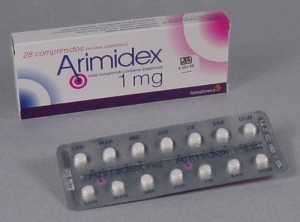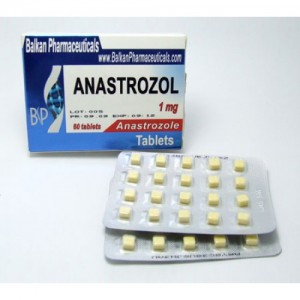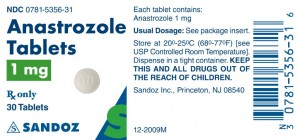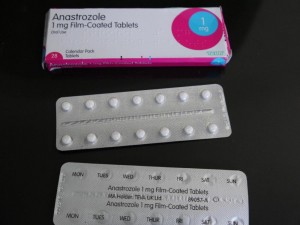Overview and History of Arimidex
Arimidex belongs to a category and class of drugs known as aromatase inhibitors (AIs). Aromatase inhibitors belong to an even broader class of drugs known as anti-estrogens. The other subcategory of drug under the anti-estrogens category is known as selective estrogen receptor modulators (SERMs), such as Nolvadex and Clomid. AIs and SERMs make up anti-estrogens. Aromatase inhibitors differ greatly from SERMs in their action and how they deal with the issues of estrogen control. The misunderstanding that SERMs, such as Nolvadex and Clomid, serve to lower estrogen levels must first be addressed. This is a persistent rumor among the anabolic steroid using community that has begun to erode as of late, but the rumor still persists. SERMs serve to block the action of Estrogen at the receptor sites in breast tissue by occupying the receptor sites in place of Estrogen so that Estrogen itself cannot exert its effects there through receptor site binding. Conversely, SERMs will also act as Estrogens at receptor sites at other cells in other areas of the body (the liver, for example in Nolvadex’s case). SERMs do not lower circulating levels of Estrogen in blood plasma. Aromatase inhibitors serve to do this by eliminating the production of Estrogen through binding to and disabling the aromatase enzyme, which is the enzyme responsible for the conversion (or aromatization) of androgens into Estrogen.
Arimidex is an aromatase inhibitor developed by Zeneca Pharmaceuticals (now AstraZeneca) that was originally synthesized and designed for the treatment of female patients suffering from advanced breast cancer. It was approved for use by the FDA and released onto the American prescription drug market in 1995. Arimidex is regarded as one of the newer aromatase inhibitors, known as a third generation aromatase inhibitor[1]. The reason as to why both aromatase inhibitors and SERMs act to block Estrogen’s effects in different manners is because it has been found that the vast majority of breast cancers are stimulated and accelerated by Estrogen.
Arimidex is used among breast cancer treatments as what is known as an adjunct treatment. This usually refers to an additional treatment when other standard treatments have failed to meet proper expectations. Prior to the development and release of Arimidex as a breast cancer treatment medication, the primary medication utilized for treatment for decades prior was Nolvadex (Tamoxifen). Nolvadex is considered to be utilized as the first and standard treatment for breast cancer patients. When Nolvadex treatment,for one reason or another, fails to meet expectations during breast cancer treatment, second-line adjunct drugs such as Arimidex are utilized.
One such study on Arimidex on over 9,000 post-surgery female breast cancer patients observed its efficiency in comparison to Nolvadex (both alone as well as both utilized simultaneously), resulting in far more favorable outcomes for Arimidex over Nolvadex[2]. The study, which was performed in 2002, concluded that Arimidex was far more effective at cancer regression, as well as increasing the survival rate of the breast cancer patients following treatment[3]. It was then this study (as well as others) that then of course prompted individuals among the anabolic steroid using community to take notice of it and begin investigating the benefits of its effects on strong Estrogen levels suppression. A study conducted later on demonstrated that the risk of recurrence of breast cancer was eliminated by 40% with Arimidex use, but the patients experienced an increase in bone fractures[4]. This is because Estrogen plays a central role in the proper maintenance of bone and its mineral retention, and this will become significantly reduced following the vast reduction of Estrogen levels resultant of Arimidex administration.
Because Arimidex was the very first aromatase inhibitor for many bodybuilders to have taken notice of, it is the most popular aromatase inhibitor used among anabolic steroid users for the purpose of Estrogen control. The use among anabolic steroid using athletes is for the control of almost all Estrogen-related side effects: the manifestation of gynecomastia, water retention and bloating, rising blood pressure (as a result of water retention increases from Estrogen). This is in contrast with SERMs such as Nolvadex, which only serve to block gynecomastia. Studies have in fact demonstrated that Arimidex use in males has been effective enough to reduce circulating blood plasma levels of Estrogen by 50% at only a dose of 0.5 – 1mg daily[5]. This is a very considerable decrease in men, but can be seen as quite different from the 80% reduction in female breast cancer patients, but it must be remembered that Estrogen and how it relates to the female physiology is different from males.
Aside from the use in bodybuilders, Arimidex has also been medically used in males as well[6]. Some males exhibit abnormally high Estrogen levels of many different reasons and Arimidex has been utilized in order to combat these ailments. In particular, Arimidex has been used to treat male adolescents that exhibit excessive Estrogen levels during purberty, resulting in unwanted pubertal gynecomastia[7] [8]. In addition, excessive Estrogen levels in adolescent males during puberty can often result in stunted growth due to the fact that Estrogen plays a key role in fusing the growth plates of the bones shut, preventing any further linear growth, and Arimidex has also been used to treat these conditions as well[9] [10].
Chemical Characteristics of Arimidex
Arimidex is a non-steroidal aromatase inhibitor. This is to say that it does not possess the characteristic four ring cycloalkane ring carbon structure common of all types of steroids.
Properties of Arimidex
Arimidex’s effects on serum Estrogen level control can be quite drastic even at a dose of 1mg daily. The amount of Estrogen suppression resulting from this dose has been demonstrated to be over 80% in patients. Arimidex can be so effective at inhibiting the aromatase enzyme and thereby reducing Estrogen levels that this compound is typically only administered to post-menopausal females, and/or utilized when other first-line treatments for breast cancer has failed.
Arimidex and Letrozole are both classified as non-steroidal and non-suicidal aromatase inhibitors that compete with the substrate for binding to the enzyme active site. This is very different from Aromasin (Exemestane), which is a steroidal and suicidal aromatase inhibitor that acts as a mechanism-based steroidal inhibitor that mimics the substrate, is converted by the enzyme to a reactive intermediate, and results in the inactivation of the aromatase enzyme . For ease of understanding, what this means to the layman is that Aromasin’s chemical structure resembles the traditional ‘targets’ that aromatase binds to (Testosterone, for example) and that it essentially ‘fools’ the aromatase enzyme into binding with it, only to become inhibited/deactivated. Because the binding strength is so great, this inhibition becomes permanent for the aromatase enzyme that Aromasin has become bound to. Arimidex and Letrozole, being non-suicidal aromatase inhibitors, both compete with the enzyme’s traditional ‘targets’ rather than being assured a permanent spot (which is the advantage that Aromasin has over the other two).
Bodybuilders and athletes utilizing anabolic steroids will usually favor aromatase inhibitors such as Arimidex for its ability to eliminate rising Estrogen levels at its root cause: aromatase. By disabling the aromatase enzyme, supraphysiological levels of aromatizable androgens (such as Testosterone, Dianabol, Boldenone, etc.) cannot convert into Estrogen, thereby eliminating any possible risk of Estrogen-related side effects.
Arimidex Side Effects
Being that Arimidex (Anastrozole) is an ancillary compound for the purpose of Estrogen control within the body, it is a compound that is generally well tolerated by male users. There are, however, some Arimidex side effects to be concerned about. This primarily exists in the form of excess reduction of blood plasma levels of Estrogen in the body, as well as long-term Estrogen suppression. Arimidex does affect females in a far greater and significant manner than it does in male users as well.
When it comes to Estrogen reduction and suppression, it must be understood that unlike SERMs (Selective Estrogen Receptor Modulators) such as Nolvadex or Clomid (Clomiphene Citrate), Arimidex belongs to the family of aromatase inhibitors. This means that it serves to disable the aromatase enzyme, which is responsible for the aromatization – or, conversion – of Testosterone into Estrogen. In other words, Arimidex reduces total circulating Estrogen levels at the root source as opposed to SERMs, which serve to merely block the activity of Estrogen at select receptor sites.
Studies have demonstrated that Arimidex use results in the increased incidence and probability of experiencing bone fractures. Although this is a more female-specific side effect of Arimidex use, Estrogen does play an important role in the promotion and retention of bone mineral content in males as well. There have been studies conducted that discovered that Arimidex does negatively impact calcium turnover levels in bone tissue with even short term use.
Lethargy and fatigue is commonly associated with Arimidex use. As with nearly all Estrogen reduction compounds, a reduction in circulating Estrogen levels means that the important role that Estrogen plays in the CNS (Central Nervous System) is reduced, thus resulting in possible instances of chronic fatigue. This is usually the result of Estrogen levels being reduced to levels that are considered far too low to be healthy.
One particularly prominent side effect of Arimidex use is the negative impact on blood cholesterol profiles. As with nearly all Estrogen reducing compounds, Arimidex will also decrease HDL (good) cholesterol and increase LDL (bad cholesterol). This is because Estrogen is responsible for the promotion of healthy cholesterol levels in the body, and a disruption of normal blood plasma levels of Estrogen will indeed throw that off. Of course, it also goes without saying that the more severe reduction of Estrogen, the more severe the cardiovascular impacts will be in this area.
One Arimidex side effect of importance is the possibility of Estrogen rebound. This exists in particular with two of the three most popular aromatase inhibitors (Arimidex and Letrozole). The third aromatase inhibitor, Aromasin (Exemestane) does not share this same attribute of the possibility of Estrogen rebound. This is because unlike Aromasin, Arimidex is a non-suicidal aromatase inhibitor. This means that Arimidex will bind with and disable the aromatase enzyme, but it does not do it permanently. At some point, Arimidex will dissociate with the enzyme and the enzyme will then be free to do its job again in the body. What this means for the end user is the risk of a rebound of Estrogen levels (and thus, Estrogen related side effects) if Arimidex use is halted too soon or abruptly after beginning use.
Dosing and Administration of Arimidex
Medically, Arimidex (Anastrozole) is utilized as a medication in the treatment of post-menopausal female breast cancer where Estrogen has been determined to be the prime cause. The prescription dosing and administration of Arimidex in these cases call for 1mg taken once per day, until the progression of the cancer has stopped.
Arimidex For Gynecomastia and Estrogen Control On-Cycle
For the purpose of Gynecomastia control and general on-cycle Estrogen control, Arimidex is to be used at a general range of 0.5 – 1mg per day, and can be adjusted depending on the user’s tolerance and reaction to the compound. Everyone should adjust their Arimidex dosage according to their individual response. It is not uncommon for 0.5mg/day to even be too much (or too little) for some. It should also always be remembered that the purpose here is Estrogen control during a cycle, not total elimination of Estrogen levels.
Arimidex For Post Cycle Therapy (PCT)
As Arimidex has been shown in studies to assist in the generation of endogenous natural Testosterone production in males, an Arimidex dosage of 0.5mg to 1mg per day should be sufficient for the duration of any PCT length.
Arimidex possesses a half-life of approximately 48 hours, and it is important to also understand that peak blood plasma levels will not be achieved with Arimidex until a full week (7 days) of consistent use is achieved. Arimidex can also be taken at any time of day, with or without food..
Arimidex Legality & Availability
Arimidex is largely an uncontrolled substance in the vast majority of the world. In Canada and the United States in particular, it is a prescription-only product, but it is not a controlled substance and therefore legal or own, purchase, and possess – though it is not available over the counter here. In the UK, Arimidex legality is the same. In many countries in Eastern Europe, Asia, and the Middle East, Arimidex is often openly available over the counter.
How to Buy Arimidex
Arimidex is perhaps the most popular anti-estrogen and aromatase inhibitor among the three (Arimidex, Letrozole, and Aromasin), and as such, it is a very popular ancillary compound for use among bodybuilders and athletes using anabolic steroids. It then goes without saying that this is a product that should be easy to find and buy, and should be in the inventory of almost any anabolic steroid source, website, or dealer. One point to take into consideration is that this product is not a cheap one. It is perhaps one of the most expensive ancillary compounds available to buy. As usual, there exists three different product types of Arimidex: pharmaceutical grade, underground laboratory (UGL) grade, and research chemical grade products. Each differ in quality, pricing, and consistency for obvious reasons.
Depending on the source, pharmaceutical grade Arimidex can be bought from most sources within the range of $7 – $11 per 1mg tablet. Underground (UGL) grade Arimidex goes for $1.30 – $8 per 1mg tablet. The price range for this product is quite large, primarily because it depends on not just the source or dealer purchased from, but also the brand of product. Finally, research grade Arimidex is usually packaged in liquid form in a bottle with a pump spray or dropper for administration, and are usually concentrated at 1mg per ml within a 30ml bottle. A single 30ml bottle can go for $40 – $70, depending on the research chemical company.
Arimidex Pictures:
Anastrozole Chemical Information:
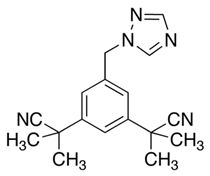 Anastrozole (AKA Arimidex)
Anastrozole (AKA Arimidex)
Chemical Name: 2,2′-[5-(1H-1,2,4-triazol-1-ylmethyl)-1,3-phenylene]bis(2-methylpropanenitrile)
Molecular Weight: 293.366 g/mol
Formula: C17H19N5
Original Manufacturer: AstraZeneca
Half Life: 46 – 48 hours (approximately 2 days)
Detection Time: 2 weeks
Anabolic Rating: N/A
Androgenic Rating: N/A
Arimidex References:
[1] Preclinical pharmacology of “Arimidex” (anastrozole; ZD1 033)–a potent, selective aromatase inhibitor. J Steroid Biochem Mol Bioi 1996 Jul;58(4):439-45.
[2] Anastrozole alone or in combimation with tamoxifen versus tamoxifen alone for adjunctive treatment of postmenopausal women with early breast cancer. Frist results of the ATAC randomized trial. Lancet 2002; 359:2131-39.
[3] History and Advancement of Anastrozole in the Treatment of Breast Cancer. Edited by Aman Buzdar &Michael Baum. RSM Press, February 2003.
[4] “Switching of postmenopausal women with endocrine-responsive early breast cancer to anastrozole after 2 years’ adjuvant tamoxifen: combined results of ABCSG trial 8 and ARNO 95 trial”. Jakesz R, Jonat W, Gnant M, Mittlboeck M, Greil R, Tausch C, Hilfrich J, Kwasny W, Menzel C, Samonigg H, Seifert M, Gademann G, Kaufmann M, Wolfgang J (2005). Lancet 366 (9484): 455–62. doi:10.1016/S0140-6736(05)67059-6. PMID 16084253.
[5] “Effects of aromatase inhibition in elderly men with low or borderline-low serum testosterone levels”. Leder BZ, Rohrer JL, Rubin SD, Gallo J, Longcope C (March 2004). J. Clin. Endocrinol. Metab. 89 (3): 1174–80. doi:10.1210/jc.2003-031467. PMID 15001605.
[6] “Estrogen suppression in males: metabolic effects”. Mauras N, O’Brien KO, Klein KO, Hayes V (July 2000). J. Clin. Endocrinol. Metab. 85 (7): 2370–7. doi:10.1210/jc.85.7.2370. PMID 10902781.; Dougherty RH, Rohrer JL, Hayden D, Rubin SD, Leder BZ (February 2005). “Effect of aromatase inhibition on lipids and inflammatory markers of cardiovascular disease in elderly men with low testosterone levels”. Clin. Endocrinol. (Oxf) 62 (2): 228–35. doi:10.1111/j.1365-2265.2005.02205.x. PMID 15670201.
[7] “Delayed closure of epiphyseal cartilages induced by the aromatase inhibitor anastrozole. Would it help short children grow up?”. Faglia G, Arosio M, Porretti S (December 2000). J. Endocrinol. Invest. 23 (11): 721–3. PMID 11194703.
[8] “Pharmacokinetics and pharmacodynamics of anastrozole in pubertal boys with recent-onset gynecomastia”. Mauras N, Bishop K, Merinbaum D, Emeribe U, Agbo F, Lowe E (August 2009). J. Clin. Endocrinol. Metab. 94 (8): 2975–8. doi:10.1210/jc.2008-2527. PMID 19470631.
[9] “Delayed closure of epiphyseal cartilages induced by the aromatase inhibitor anastrozole. Would it help short children grow up?”. Faglia G, Arosio M, Porretti S (December 2000). J. Endocrinol. Invest. 23 (11): 721–3. PMID 11194703.
[10] “Anastrozole increases predicted adult height of short adolescent males treated with growth hormone: a randomized, placebo-controlled, multicenter trial for one to three years”. Mauras N, Gonzalez de Pijem L, Hsiang HY, Desrosiers P, Rapaport R, Schwartz ID, Klein KO, Singh RJ, Miyamoto A, Bishop K (March 2008). J. Clin. Endocrinol. Metab. 93 (3): 823–31. doi:10.1210/jc.2007-1559. PMC 2266949. PMID 18165285.




